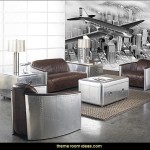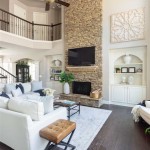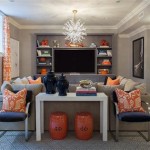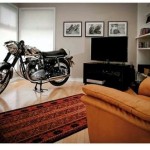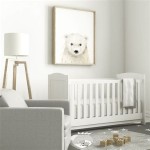Dining Room Mirror Decorating Ideas: Enhancing Space and Style
Mirrors are versatile decorative elements that transcend mere functionality. In the dining room, a strategically placed mirror can dramatically alter the ambiance, amplifying space, enhancing light, and adding a touch of sophistication. Choosing the right mirror and incorporating it effectively requires careful consideration of the room's dimensions, existing decor, and desired aesthetic. This article explores various dining room mirror decorating ideas, providing guidance on selecting the appropriate style, size, and placement to maximize their impact.
Reflecting Light and Creating Illusion: The Power of Mirror Placement
One of the primary benefits of incorporating a mirror into a dining room is its ability to reflect and distribute natural and artificial light. Placement is paramount in achieving this effect. Placing a mirror opposite a window is a particularly effective technique. The mirror will act as a secondary light source, bouncing the incoming natural light back into the room, brightening dark corners and minimizing the need for artificial illumination during the day. This is especially beneficial in dining rooms with limited window space or those situated in areas with less sunlight exposure.
The size of the mirror relative to the light source is also crucial. A larger mirror will reflect more light, while a smaller mirror may create a more subtle effect. Experimenting with different sizes and positions can help determine the optimal placement for maximizing brightness. Consider the view reflected in the mirror. If the window overlooks an unattractive vista, placing the mirror elsewhere might be preferable. Instead, consider positioning the mirror to reflect a particularly appealing architectural detail, a favorite piece of artwork, or a decorative lighting fixture.
Mirrors can also be used to create the illusion of a larger space. This is particularly useful in smaller dining rooms where maximizing the perceived square footage is a priority. A large, wall-mounted mirror can visually expand the room, making it feel more open and airy. The mirror effectively doubles the visual space, creating a sense of depth and spaciousness. Consider the shape of the mirror as well. A rectangular mirror can elongate a room, while a round mirror can soften harsh angles and add a touch of visual interest.
Vertical mirrors, placed strategically on walls, can also give the impression of higher ceilings. This is especially effective in rooms with lower ceiling heights, where the vertical emphasis can create a more balanced and proportionate feel. In long, narrow dining rooms, placing a mirror on one of the shorter walls can help to visually widen the space, creating a more balanced and inviting atmosphere. Avoid placing mirrors directly opposite doorways if they reflect cluttered or unappealing views. Instead, focus on reflecting positive aspects of the room or the surrounding environment.
Styles and Frame Options: Complementing Existing Decor
The style of the mirror and its frame should complement the existing decor of the dining room. From ornate and traditional to sleek and modern, the options are vast, and selecting the right style is essential for achieving a cohesive and harmonious look. Consider the overall aesthetic of the room, including the furniture, wall colors, and other decorative elements. The mirror should enhance these elements, not detract from them.
For a traditional dining room, consider a mirror with an ornate, gilded frame. These frames often feature intricate details, such as carvings, scrolls, and floral motifs, adding a touch of elegance and refinement. Antique mirrors with distressed finishes can also be a good choice for traditional spaces, adding character and a sense of history. The frame material can range from wood to metal, with options such as gold, silver, or bronze finishes. Choose a finish that complements the other metallic accents in the room, such as the hardware on the furniture or the finish of the lighting fixtures.
For a modern dining room, opt for a mirror with a simpler, more minimalist frame. Clean lines, geometric shapes, and understated finishes are characteristic of modern design. Frameless mirrors are also a popular choice for contemporary spaces, creating a sleek and seamless look. Consider a mirror with a thin metal frame in a neutral color, such as black, silver, or white. These colors are versatile and can easily blend in with a variety of modern decor schemes. Geometric shapes, such as squares, rectangles, and circles, are also well-suited for modern dining rooms.
For a rustic or farmhouse-style dining room, consider a mirror with a wooden frame. Reclaimed wood, distressed finishes, and natural textures are all hallmarks of rustic design. A large, rectangular mirror with a chunky wooden frame can create a focal point in the room, adding warmth and character. Consider a frame with exposed wood grain or a whitewashed finish for a more authentic rustic look. Alternatively, an antique mirror with a weathered frame can add a touch of vintage charm.
Consider also the shape of the mirror in relation to the room's architecture. A round mirror can soften the hard lines and angles of a room, while a rectangular mirror can emphasize the horizontal or vertical dimensions. An oval mirror can add a touch of elegance and sophistication, while a square mirror can create a sense of balance and symmetry. Experiment with different shapes and sizes to find the perfect fit for your dining room.
Creating a Focal Point: Mirror as a Statement Piece
A mirror can serve as a striking focal point in the dining room, drawing the eye and adding a touch of drama. Selecting a mirror with unique features, such as an unusual shape, a bold frame, or a decorative design, can transform it into a captivating statement piece. The mirror should be positioned in a prominent location, where it can be easily seen and appreciated.
Consider a large, oversized mirror to create a dramatic focal point. A mirror that spans a significant portion of the wall can have a powerful impact, instantly transforming the room's aesthetic. Choose a frame that complements the existing decor but also stands out in its own right. A mirror with a bold color, an intricate pattern, or an unusual texture can add visual interest and personality to the space. For instance, a mirror with a mosaic tile frame or a frame adorned with shells can add a touch of whimsy and character.
Another option is to create a gallery wall of mirrors. This involves grouping together several smaller mirrors of different shapes, sizes, and styles to create a visually engaging display. A gallery wall of mirrors can add texture, depth, and visual interest to the room. Experiment with different arrangements and compositions to find the perfect balance. Consider using mirrors with different frame styles to create a more eclectic and personalized look. This approach allows for greater flexibility and creativity in decorating the dining room.
Mirrors with interesting shapes can also serve as captivating focal points. Consider a sunburst mirror, which features a central mirror surrounded by radiating rays. These mirrors are particularly effective in adding a touch of glamour and sophistication to the dining room. Alternatively, a mirror with an asymmetrical shape can add a modern and artistic touch. Abstract shapes and unconventional designs can make a bold statement and create a unique focal point.
Mirrors with decorative embellishments can also be used to create a focal point. Consider a mirror with embedded crystals, mirrored tiles, or other decorative accents. These embellishments can add sparkle and shine to the room, creating a sense of luxury and elegance. A mirror with a built-in lighting feature can also create a dramatic focal point, illuminating the room and highlighting the mirror's design. Ultimately, the choice of mirror should reflect your personal style and complement the overall aesthetic of the dining room.
When selecting a mirror to serve as a focal point, consider the scale of the room and the surrounding furniture. The mirror should be proportionate to the size of the wall and the other elements in the room. Avoid choosing a mirror that is too small, as it may get lost in the space. Conversely, avoid choosing a mirror that is too large, as it may overwhelm the room and create an unbalanced look. Carefully consider the placement of the mirror to ensure that it is positioned in a way that enhances its visual impact and creates a cohesive and harmonious design.

How To Decorate Your Home With Mirrors In Some Stunning Ways World Inside S Mirror Dining Room Elegant Luxury

How To Use Wall Sconces Design Tips Ideas Mirror Dining Room Walls Decor

Transform Your Dining Room With A Mirror Decoholic

Mirror Décor Ideas How To Decorate With Mirrors

Here S All The Inspiration You Need To Decorate With Mirrors Dining Room Mirror Decor

Should I Need A Dining Room Mirror Ideas

Transform Your Dining Room With A Mirror Decoholic

How To Decorate With Mirrors Decorating Ideas For

How To Decorate With Mirrors 25 Mirror Decorating Ideas

25 Wall Mirror Decorating Ideas That Will Enhance Your Home Decor
Related Posts
